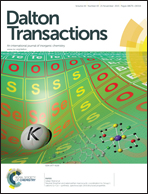Luminescent pentafluorophenyl-cycloplatinated complexes: synthesis, characterization, photophysics, cytotoxicity and cellular imaging†
Abstract
Luminescent mono(pentafluorophenyl) cycloplatinated complexes [Pt(C^N-κC,N)(HC^N-κN)(C6F5)] [HC^N = Hthpy (2-(2-thienyl)pyridine) 2a, Hbt (2-phenylbenzothiazole) 2b, Hpq (2-phenylquinoline) 2c] have been prepared by C–H activation of a HC^N ligand in the corresponding [Pt(HC^N-κN)2(C6F5)2] (1a, 1b, 1c) complexes. Complexes 2 evolve in DMSO solution into solvate complexes and we present here successful routes for the synthesis of [Pt(C^N)(C6F5)(DMSO)] (C^N = thpy 3a, bt 3b). They have been fully characterized (X-ray for 1a, 1c, 2b, 3a and 3b), their electronic absorption and emission properties have been investigated and DFT and TD-DFT calculations for 1a, 1c, 2b and 3a have been carried out. Complexes 3a, 3b and [Pt(ppy)(C6F5)(DMSO)] 4 (Hppy = 2-phenylpyridine) show remarkable stability in a mixed DMSO-cellular medium and their cytotoxicity towards the human lung tumor (A549) and bronchial epithelial non-tumorigenic (NL20) cell lines has been evaluated by MTS assays. Their cellular localization in A549 and NL20 human cells and in mouse embryonic fibroblasts obtained from lungs (LMEFs) has also been investigated by fluorescence microscopy.


 Please wait while we load your content...
Please wait while we load your content...